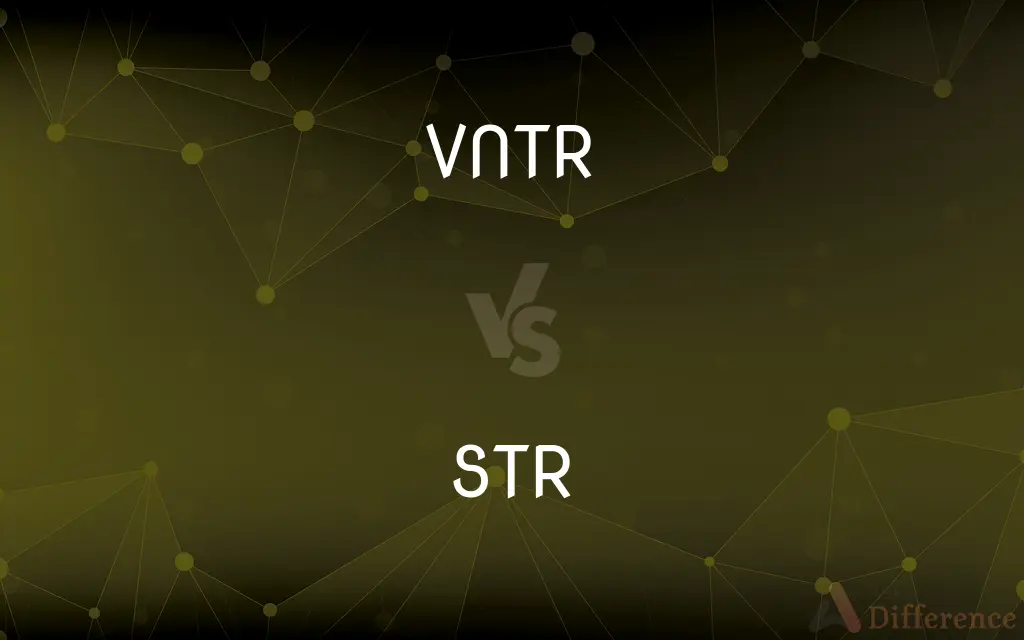VNTR vs. STR — What's the Difference?
By Tayyaba Rehman — Published on December 14, 2023
VNTR refers to Variable Number Tandem Repeats, long sequences of DNA repeated consecutively; STR stands for Short Tandem Repeats, shorter sequences of consecutive DNA repeats.

Difference Between VNTR and STR
Table of Contents
ADVERTISEMENT
Key Differences
VNTR and STR are both types of tandem repeat sequences found in DNA. VNTR, or Variable Number Tandem Repeats, comprises longer segments of DNA repeated in a consecutive manner. These repeats can be quite variable in length, ranging from about 10 to over 100 base pairs. STR, on the other hand, refers to Short Tandem Repeats. As the name suggests, STR consists of shorter segments, typically between 2 to 6 base pairs, repeated in a row.
In the field of forensic science, both VNTR and STR have significant applications. VNTR was one of the first methods used in DNA fingerprinting. Given the large size and variability of VNTR regions, they can offer a unique DNA profile for individuals. STR, due to its shorter length and higher occurrence in the human genome, is now more commonly used in DNA profiling. STR analysis is often more reliable and requires less DNA, making it preferable in forensic contexts.
From a technical standpoint, analyzing VNTR requires more DNA and can sometimes be less precise due to the longer length of the repeat sequences. STR, with its shorter repeat units, can be analyzed with more precision, even with degraded DNA samples. The evolution from VNTR to STR in forensic settings signifies the advancements in technology and the demand for more accurate, faster results.
In terms of evolution and genetics, both VNTR and STR play roles in genetic diversity. VNTR regions can contribute to genetic variation among populations, influencing traits and susceptibilities to certain conditions. STR, with its widespread presence across the genome, can also play a role in genetic diversity, evolution, and even some genetic disorders.
Comparison Chart
Full Form
Variable Number Tandem Repeats
Short Tandem Repeats
ADVERTISEMENT
Length of Repeat Sequence
10 to over 100 base pairs
2 to 6 base pairs
Forensic Application
Earlier DNA fingerprinting
Commonly used in modern DNA profiling
Analysis Precision
Can be less precise
More precise, even with degraded DNA
Influence on Genetics
Contributes to genetic variation
Role in genetic diversity & disorders
Compare with Definitions
VNTR
VNTR refers to consecutive repeats of longer DNA sequences.
VNTR was foundational in early DNA fingerprinting techniques.
STR
STR regions are prevalent throughout the human genome.
The high occurrence of STR regions aids in detailed DNA analysis.
VNTR
VNTR regions can be highly variable among individuals.
The uniqueness of VNTR patterns makes them useful in genetic studies.
STR
STR is a DNA segment with short, repeated sequences.
STR analysis is a cornerstone in modern forensic DNA profiling.
VNTR
VNTR is a section of DNA with long repeating sequences.
In DNA analysis, the variability in VNTR regions can distinguish individuals.
STR
STR offers a precise method for DNA profiling.
Even minute DNA samples can be analyzed using STR techniques.
VNTR
VNTRs contain tandemly repeated DNA segments of variable lengths.
Some genetic disorders have been linked to specific VNTR patterns.
STR
STR involves consecutive repeats of shorter DNA segments.
Due to its precision, STR is often preferred over VNTR in forensics.
VNTR
VNTR offers insights into genetic diversity and evolution.
Studying VNTR can shed light on population genetics and ancestry.
STR
STRs are integral to genetic diversity and some genetic disorders.
Abnormal STR lengths can be indicative of certain genetic conditions.
STR
(music) string
STR
(historical) steamer A vessel propelled by steam.
STR
(programming) string {{qual}}
STR
(microbiology) strain
STR
Abbreviation of strength
STR
(uncountable) stremma(ta), a Greek unit of land area now equivalent to the decare (1000 m²).
STR
Abbreviation of strong
STR
Abbreviation of strict
STR
Abbreviation of straight
STR
Abbreviation of strongly
STR
Abbreviation of strictly
Common Curiosities
Can VNTR provide a unique DNA profile for an individual?
Yes, VNTR regions can offer a unique DNA profile given their variability.
Which is more commonly used in modern forensics, VNTR or STR?
STR is more commonly used in modern forensics due to its precision and reliability.
What does VNTR stand for?
VNTR stands for Variable Number Tandem Repeats.
How is STR different from VNTR in terms of length?
STR consists of shorter sequences (2-6 base pairs) while VNTR has longer sequences (10-100+ base pairs).
Why is STR preferred in cases with degraded DNA?
STR, with its shorter sequences, can be analyzed more precisely even with degraded DNA samples.
How did VNTR contribute to early genetic studies?
VNTR was foundational in early DNA fingerprinting and genetic variation studies.
Why has forensic science evolved from VNTR to STR?
The shift from VNTR to STR in forensics is due to STR's precision, speed, and reliability, especially with smaller or degraded samples.
Are VNTR and STR the only types of tandem repeats in DNA?
No, VNTR and STR are just two types; there are other forms of tandem repeats in DNA.
Can STR analysis be used in ancestry studies?
Yes, STR analysis can provide insights into ancestry and genetic lineage.
Are STR regions linked to any genetic disorders?
Yes, abnormal lengths of certain STR regions can indicate specific genetic conditions.
What is the significance of STR in population genetics?
STR regions, due to their prevalence, play a role in genetic diversity and can shed light on population genetics.
Can VNTR analysis be done with small DNA samples?
VNTR analysis typically requires more DNA and can be less precise, especially with smaller samples.
Which has more variability among individuals, VNTR or STR?
Both offer variability, but VNTR regions tend to have greater variability due to their longer sequence length.
Which is more technologically challenging to analyze, VNTR or STR?
VNTR, due to its longer sequence length, can be more challenging and less precise than STR analysis.
How do VNTR and STR contribute to genetic diversity?
Both play roles in genetic variation, with VNTR influencing traits and susceptibilities and STR impacting genetic diversity and some disorders.
Share Your Discovery

Previous Comparison
WLAN vs. WWAN
Next Comparison
Fixed Exchange Rates vs. Flexible Exchange RatesAuthor Spotlight
Written by
Tayyaba RehmanTayyaba Rehman is a distinguished writer, currently serving as a primary contributor to askdifference.com. As a researcher in semantics and etymology, Tayyaba's passion for the complexity of languages and their distinctions has found a perfect home on the platform. Tayyaba delves into the intricacies of language, distinguishing between commonly confused words and phrases, thereby providing clarity for readers worldwide.














































